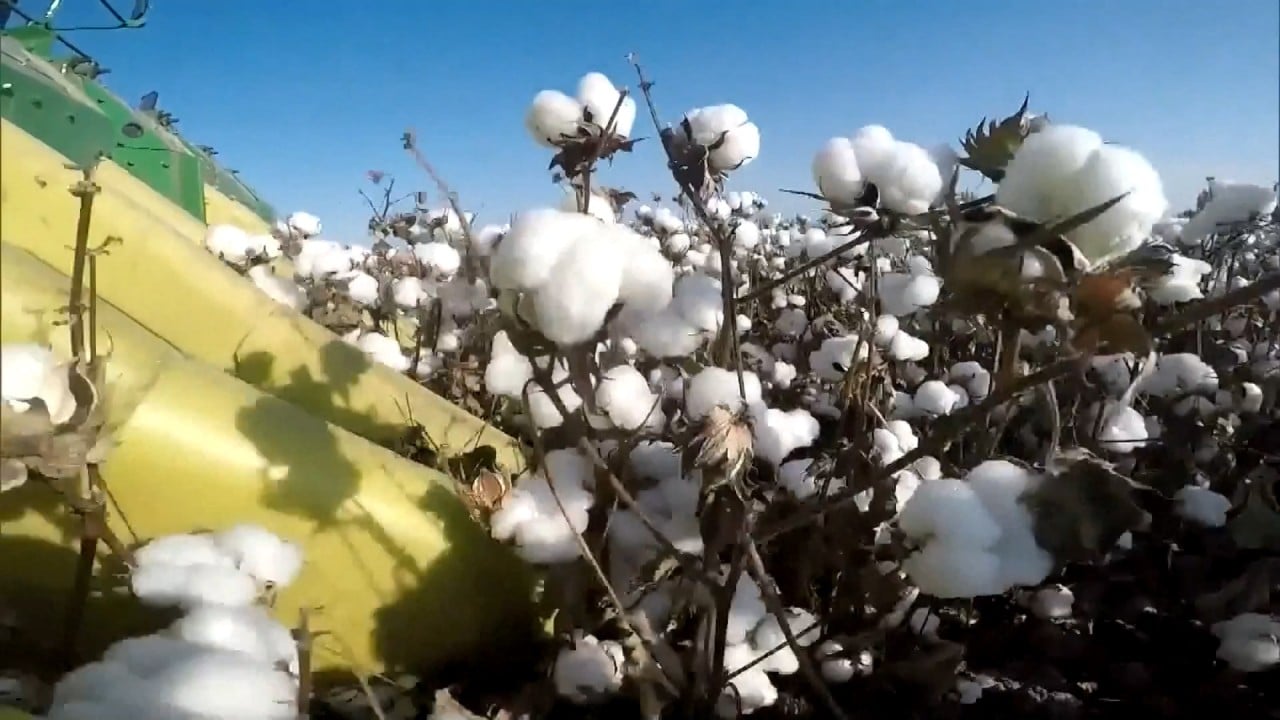
China to buy Xinjiang cotton, but state stockpiling won’t save mills from massive losses amid US ban
- To help stabilise China’s reeling cotton industry, the state will buy up to a half-million tonnes of Xinjiang cotton from mills starting on Wednesday
- But Xinjiang’s cotton-ginning mills are still likely to lose a fortune, having paid much more for raw cotton last autumn, and upstream pressure is only expected to continue
To help stabilise China’s cotton market just weeks after a crippling US ban on Xinjiang products went into effect, Beijing intends buy up to half a million tonnes of Xinjiang cotton for its state reserves – ending a 15-month drought of such purchases.
The total purchase will entail between 300,000 and 500,000 tonnes of Xinjiang cotton, which will come from mills in the region, according to a statement by the China National Cotton Reserves Corporation (CNCRC) on Friday.
The buying will take place as long as the spot price of domestic cotton stays below 18,600 yuan (US$2,770) a tonne, the CNCRC said. The spot price on Tuesday was 17,559 yuan, or more than 20 per cent less than the price in January, according to the China National Cotton Exchange.
How the US’ Xinjiang labour law leaves millions of tonnes of cotton unsold
The state stockpiler last replenished its reserves of Xinjiang cotton between December 2020 and March 2021. However, market sentiment has remained dampened since Friday’s announcement.
Cotton futures trading on the Zhengzhou Commodity Exchange continued to dip on Monday, closing at 16,440 yuan per tonne, then fell even further on Tuesday, closing at 15,990 yuan.
“The market has no more confidence,” said the owner of a cotton-ginning mill in southern Xinjiang, who spoke on condition of anonymity, adding that the state stockpile announcement “has been barely a boost” for the market.
For cotton-ginning mills, the procurement cost of raw cotton during last autumn’s harvest season was around 24,000 yuan per tonne, the owner said.
“That means we would lose at least 6,000 yuan by selling each tonne of cotton [to the national reserve],” the owner added.
The act, which lasts for eight years, has effectively blocked American imports of all products wholly or partially sourced from Xinjiang, where China has been accused of committing human rights abuses such as forced labour against Uygur Muslims and other minority groups – allegations that Beijing has repeatedly denied.
As a major global producer of cotton, Xinjiang’s annual cotton output in 2021 was 5.27 million tonnes, accounting for 91 per cent of the nation’s production, and around 20 per cent of the world’s total output.
The region does not export much raw cotton or yarn, which is mostly consumed locally or sold to other provinces to be made into cloth, garments or other textile products for domestic and overseas markets.
What is going on in Xinjiang and who are the Uygur people?
Despite the falling price, downstream textile manufacturers, especially those whose business focuses on exports, still shun the region’s crops due to the US ban, which has resulted in a massive unsold inventory: 3.3 million tonnes of cotton were taking up inventory space at Xinjiang cotton mills by the end of May, which was over a million tonnes higher than it usually was that time of the year, according to figures from Beijing Cotton Outlook Consulting.
As the state stockpile announcement has failed to boost the market, the cotton-mill owner expected that upstream suppliers such as himself will come under more pressure in the future.
“It seems the state has no intention to push up the price by only buying at the market price, and the purchase volume does not exceed expectations either,” he said.
Wu Xinyang, an analyst with China Futures, said the benefit of the stockpiling is only reflected in providing limited market liquidity, not in supporting prices.
There are expectations that more state sales of foreign cotton and purchases of Xinjiang cotton will continue
“Compared with the spot-market transaction, this round of the state reserve’s stockpile provides a way out for [cotton] processing enterprises that have difficulty in sales, and it releases a certain amount of liquidity into the market to facilitate processing enterprises to cash in on cotton resources,” Wu said.
Still, while it can hardly serve to reshape the long-term pattern of weak supply and demand in the domestic cotton market, the role of the state reserve should not be ignored, Wu added.
“Under the impact of the Xinjiang cotton ban, which strikes the entire industrial chain, there are expectations that more state sales of foreign cotton and purchases of Xinjiang cotton will continue,” Wu said.


